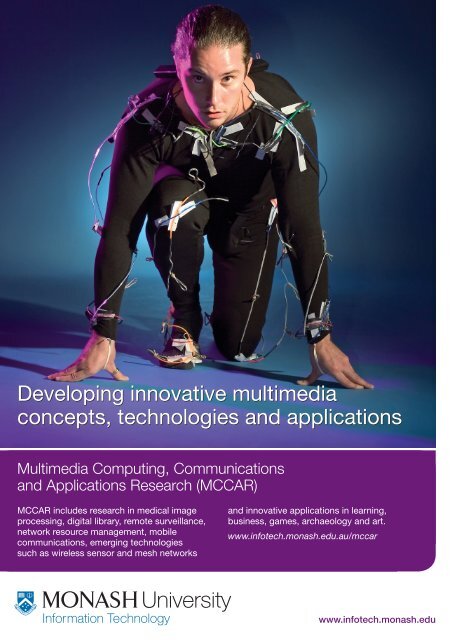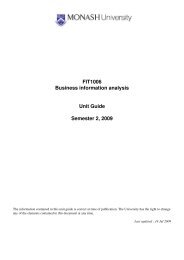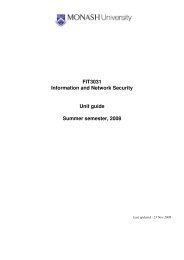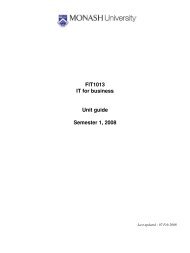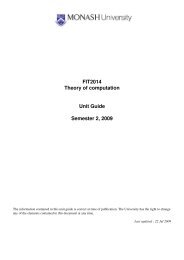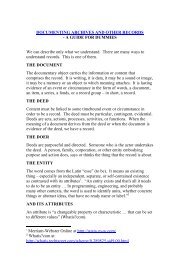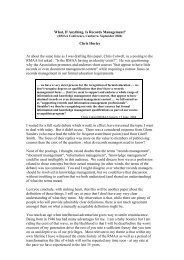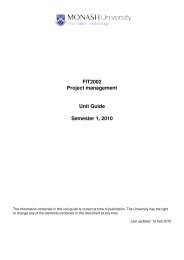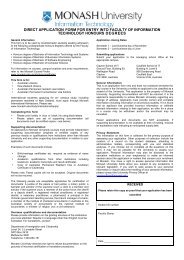Developing innovative multimedia concepts, technologies and ...
Developing innovative multimedia concepts, technologies and ...
Developing innovative multimedia concepts, technologies and ...
- No tags were found...
Create successful ePaper yourself
Turn your PDF publications into a flip-book with our unique Google optimized e-Paper software.
<strong>Developing</strong> <strong>innovative</strong> <strong>multimedia</strong><strong>concepts</strong>, <strong>technologies</strong> <strong>and</strong> applicationsMultimedia Computing, Communications<strong>and</strong> Applications Research (MCCAR)MCCAR includes research in medical imageprocessing, digital library, remote surveillance,network resource management, mobilecommunications, emerging <strong>technologies</strong>such as wireless sensor <strong>and</strong> mesh networks<strong>and</strong> <strong>innovative</strong> applications in learning,business, games, archaeology <strong>and</strong> art.www.infotech.monash.edu.au/mccarwww.infotech.monash.edu
Multimedia Signal Processing<strong>and</strong> ManagementMultimedia Signal Processing <strong>and</strong>Management focuses on two challengingissues:1. How to reduce the amount of storage<strong>and</strong> communication b<strong>and</strong>widthrequirement by developing <strong>innovative</strong>compression techniques.2. How to extract <strong>and</strong> represent<strong>multimedia</strong> features for effective <strong>and</strong>efficient indexing <strong>and</strong> retrieval.Current research projects include:• Very low bit rate video compression:this Australian Research CouncilDiscovery Project is developing a realtimepattern-base low bit rate videocoding for low powered <strong>and</strong> limitedprocessing electronics devices.• Automatic <strong>multimedia</strong> informationindexing <strong>and</strong> retrieval: to developtechniques for automatic featureextraction, indexing <strong>and</strong> retrieval ofdigital audio, image <strong>and</strong> video.• Image database visualisation: toprovide effective content overview.• Advanced image processing includingimage segmentation, face recognition<strong>and</strong> applications in medical imaging.Multimedia Communications<strong>and</strong> Sensor NetworksMultimedia Communication <strong>and</strong> SensorNetworks research aims to provideubiquitous <strong>and</strong> seamless communicationwith <strong>multimedia</strong> capability, <strong>and</strong> to conductremote monitoring <strong>and</strong> surveillance.Current research projects include:• Enhancing mobile <strong>multimedia</strong>communications by exploiting themobility of Information devices.• <strong>Developing</strong> <strong>innovative</strong> protocols toefficiently use network resources.• Wireless ad hoc networks.• Wireless sensor networks to provideremote monitoring <strong>and</strong> surveillance.• Quality of service provision for<strong>multimedia</strong> <strong>and</strong> wirelesscommunications.• Spectrum management in cognitiveradio.<strong>Developing</strong> InnovativeMultimedia Applications<strong>Developing</strong> Innovative MultimediaApplications focuses on research into theconceptual <strong>and</strong> technical aspects of theapplication of <strong>multimedia</strong> <strong>technologies</strong>including:• Human computer interaction• 3D graphics• Information visualisation• 3D computer games• Educational <strong>multimedia</strong>Bringing Angkor Wat to LifeAngkor’s ruined Hindu <strong>and</strong> Buddhisttemples are the most conspicuousarchitectural remains from the civilisationthat dominated mainl<strong>and</strong> South East Asiain medieval times.Recent reappraisals of past research haveunderlined the importance of the Angkoras a living city, its temples interconnectedinseparably with the communitiessurrounding them.This project aims to bring the temples <strong>and</strong>the neighbourhoods that sustained themback to life using techniques derived fromthe latest 3D graphic <strong>and</strong> game computer<strong>technologies</strong>.Through 3D reconstruction <strong>and</strong> simulationthe opportunity exists not only to recreateevery day life at Angkor but also toexp<strong>and</strong> upon traditional conceptionsof the city <strong>and</strong> make original contributionsto interpretations of its function, extent<strong>and</strong> significance.PhD student Jan Carlo Barca is wiredfor movement as he demonstrateshis motion capture system.For more information visit:www.infotech.monash.edu.au/mccarCRICOS provider: Monash University 00008CD&P 8-07


